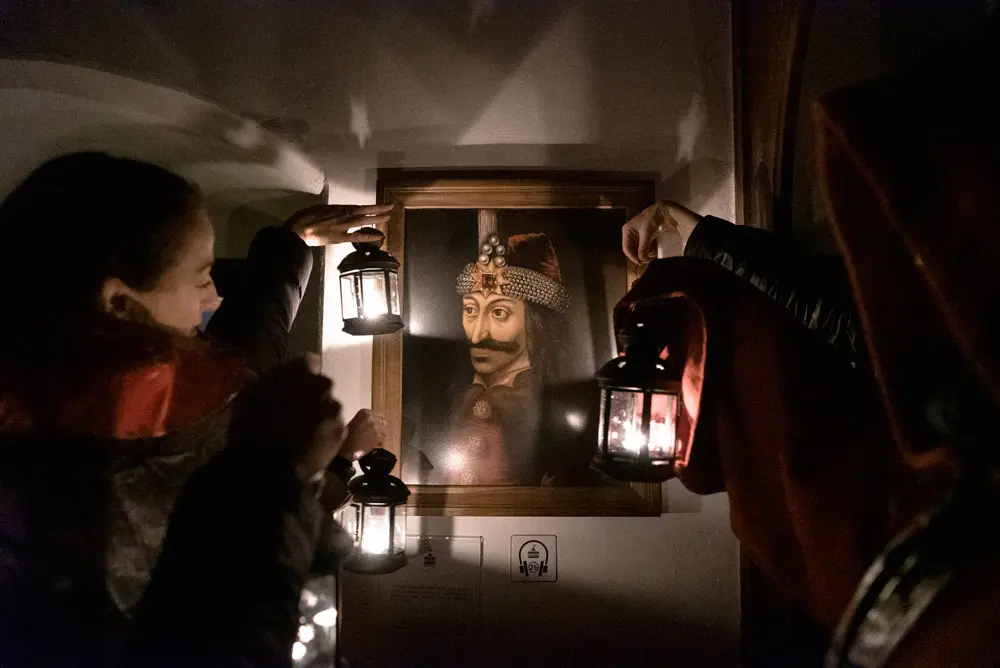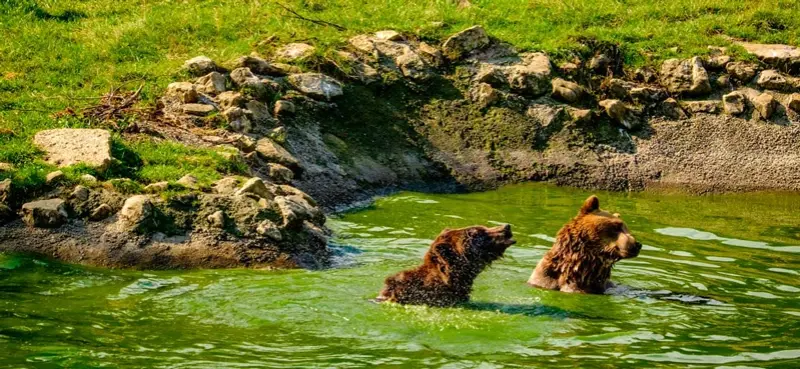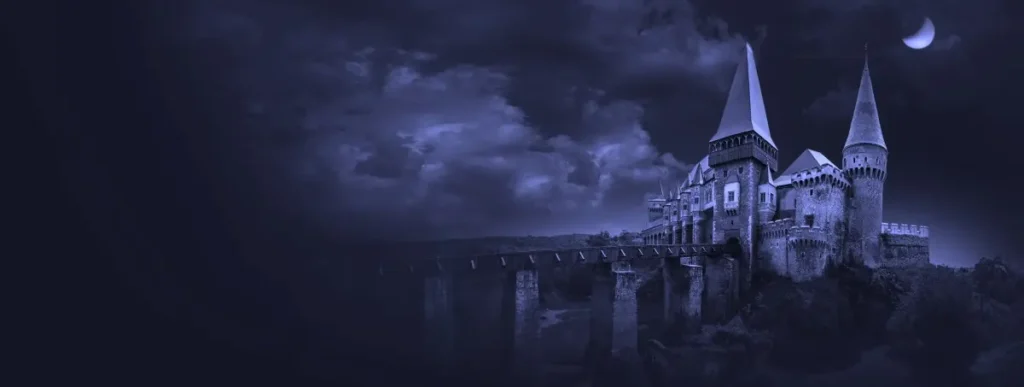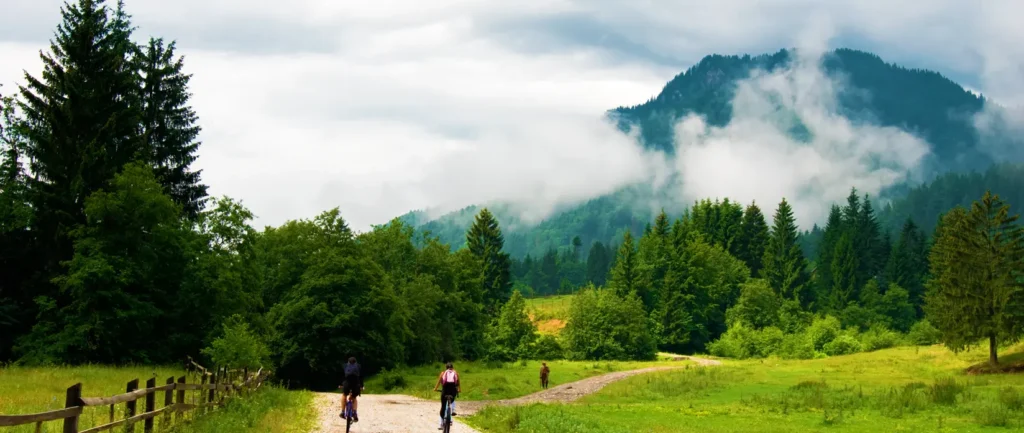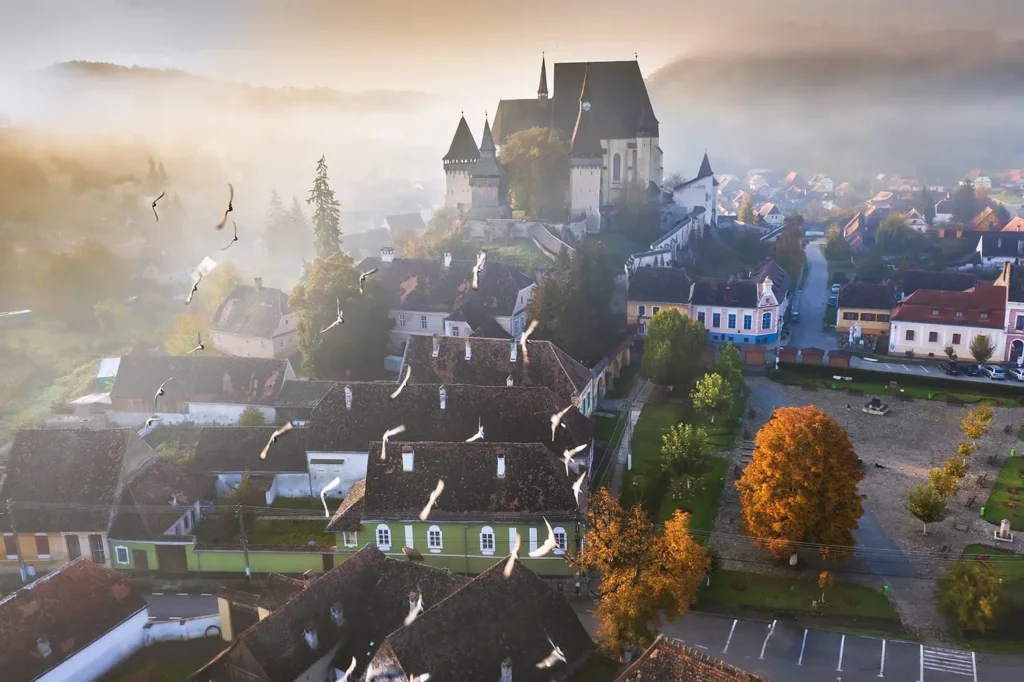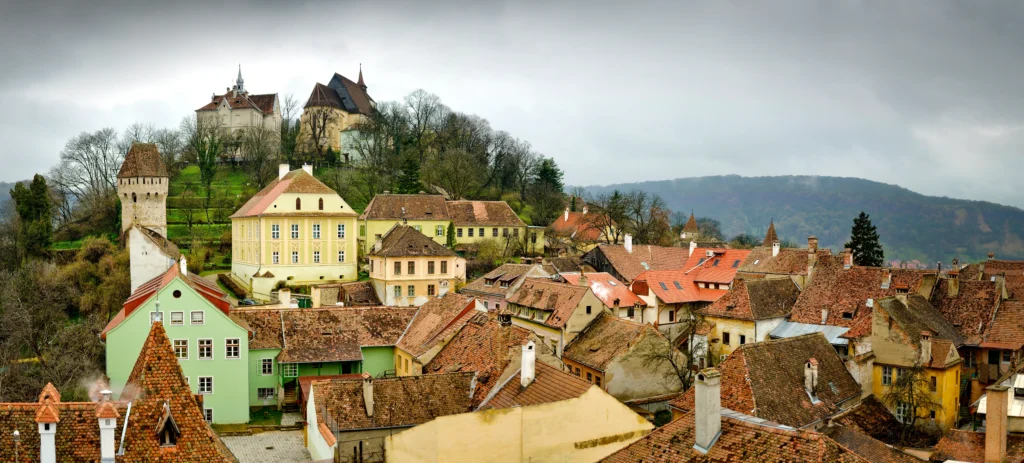Chapters
You can find Bran if you travel 28 kilometers southwest of the city of Brașov. Bran is a small town that guards the most important medieval route that connects Transylvania to Wallachia, the Rucăr-Bran Pass. In this village, at the top of a steep mountain cliff, stands Bran Castle, commonly known as Dracula’s Castle, which is by far one of the most famous castles in Transylvania and Romania, alongside Peles Castle, Corvin Castle, and Rasnov Fortress. Vampire films and novels widely popularize it. Although there is no evidence that Bram Stoker knew about Bran’s existence, the castle is often referred to as the home of his infamous character, Count Dracula. Hence the name of Dracula’s Castle.
The history of Bran Castle
Teutonic Knights
Being located in Brasov County, Bran Castle Transylvania was first built by the Teutonic Knights in 1212 as a wooden castle guarding an important mountain pass and defending the Southeastern border of Transylvania; the Mongols destroyed it in 1242.

Saxons of Transylvania
This beautiful medieval castle was first mentioned in Romanian history in documents from 1377 when the Saxons of Kronstadt built it at their own expense and labor force. The construction was completed in 1388. It had the role of a military fortress standing at the east border of Transylvania, built on a steep cliff between Magura and Dealul Cetatii. Furthermore, the castle was used as a goods trade pass as well.
John Hunyadi (Iancu de Hunedoara)
The castle was given to Prince Mircea by Sigismund of Luxembourg as an exchange of loyalty. After the Prince died in 1419, the castle was given to the princes of Transylvania. Iancu de Hunedoara defeated the Turks in Bran in 1441 and strengthened the rapport with Brasov’s people.
Besides playing an important military role in Romania’s history, Bran Castle also had a commercial purpose. Being placed at the border of two important regions, it provided safe passage from one location to another. Therefore, it improved the relations and economic development of both Wallachia and Transylvania.
Vlad the Impaler
As time passed and military conflicts intensified, the castle was heavily fortified and used over the ages as a defensive position against the invading Ottoman Empire. Despite popular belief, the real story is that Vlad the Impaler (Vlad Tepes) had little to do with the castle, although he passed through the area occasionally.
During his first and second reign, Vlad Tepes handled the situation at the border and was allied with Bran. Later on, because of Saxon’s request to raise the taxes and to support one of his opponents, the voivode attacked Brasov in 1459 and murdered hundreds of Saxons.
1498 – 1691
In 1498 Brasov bought the right to use the castle for 10 years. Even after Transylvania became a part of the Habsburg Empire in 1687, the right for the castle to the Prices of Transylvania was reconfirmed by the Leopold Diploma.
1723-1836
Until 1836, when the castle lost its military purpose but was still used as an administrative seat, the castle was damaged and renovated on some occasions. From 1888 the castle fell into deterioration.
Royal Residence
In 1920, after the Treaty of Trianon, Bran Castle became a royal residence within the Kingdom of Romania. Queen Maria of Romania did not like the court life in Bucharest, and she used to ride unattended through the streets and throw roses at the citizens during carnivals. She appointed herself a colonel of the Red Hussars.
During World War II, the castle was used as a hospital by Princess Ileana, Queen Marie’s daughter, but in 1948 it was seized by the communist regime.
Dracula’s Castle today
In 2005, the Romanian government passed a special law that allowed restitution claims on properties illegally seized by the Ceausescu regime. In 2006 the castle was awarded to the royal family, more specifically to Princess Ileana’s son, Dominic von Habsburg. In 2009 it was transferred to his sisters, Maria-Magdalena Holzhausen and Elisabeth Sandhofer. In June 2009, the renovated castle was opened together with the Bran Village to preserve and boost Romania’s tourism and improve the region’s economic situation.
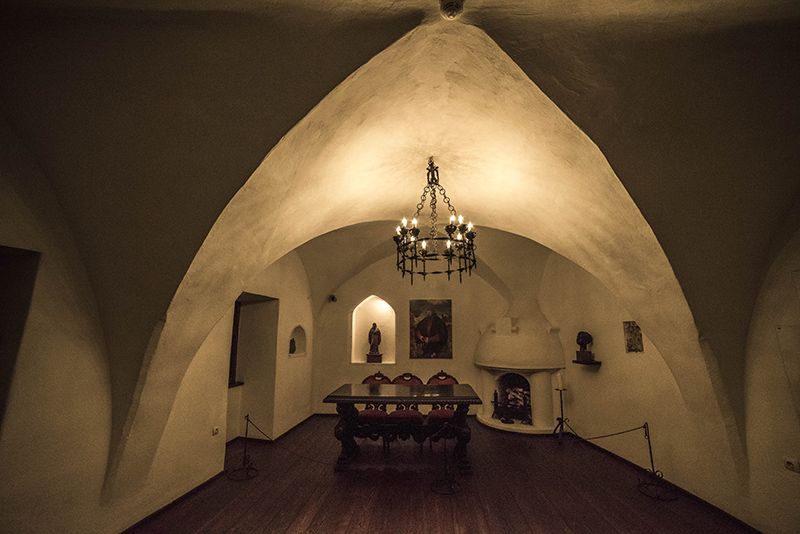
The furniture inside Bran Castle
Today the Castle (Castelul Bran) is a private museum that displays art and furniture collected by Queen Marie. Thousands of tourists visit Bran Castle each year for an authentic vampire experience, and they are not disappointed. According to the official statistics in 2019, the Bran Castle was the most visited sight in Romania, reaching 1 million visitors. The castle was restored several times, and now it looks very much like it used to during the time of its famous residents.
Surrounded by towers and ramparts, this “pugnacious little fortress,” as Queen Marie called it, is a genuinely stunning castle, especially against the beautiful background dominated by the Carpathian Mountains. Several nearby attractions, as well as Bran Castle itself, are also home to a Halloween party on the last day of November. So if you want a truly extraordinary experience, make sure to book ahead of time.
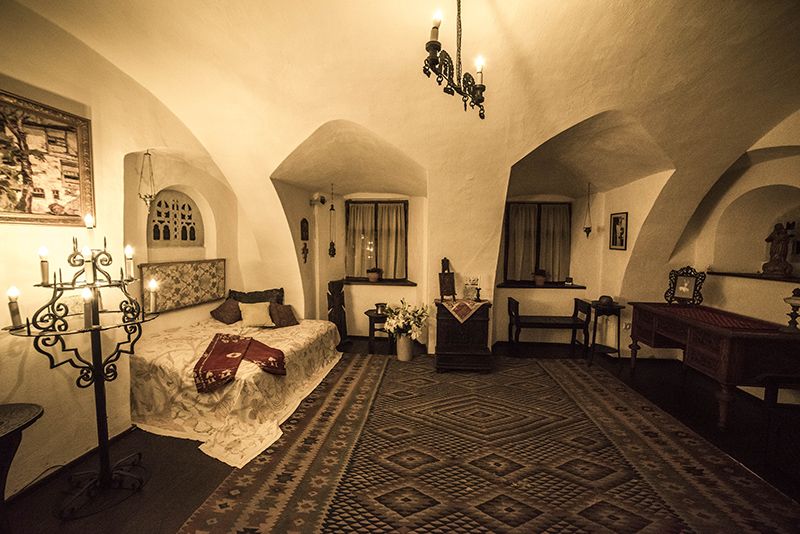
The bedroom inside Bran Castle
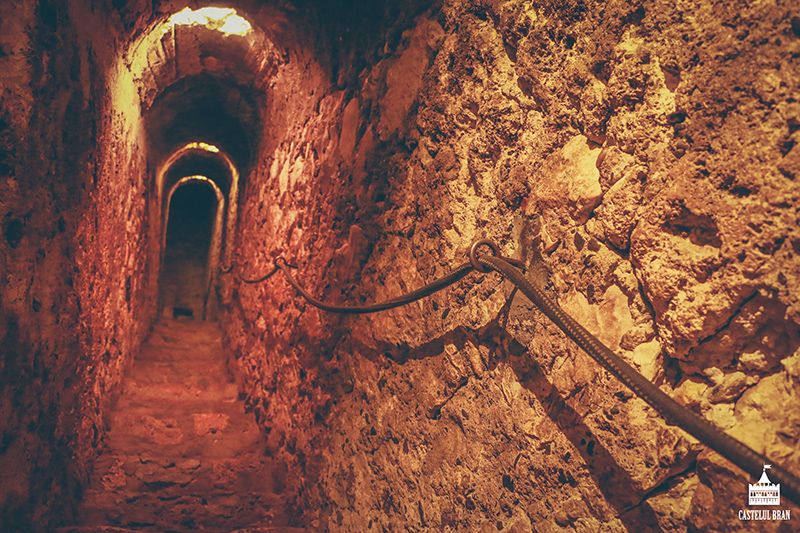
One of the tunnels inside Bran Castle
But Bran has more to offer, other than a Bran Castle tour. You can take a trip to the open-air Village Museum, which is located in the park near Bran Castle. Here, you will find 18 examples of traditional Romanian households, as well as other wooden constructions. For example, you can find a sawmill, and a fulling mill, which were used to manufacture wool, both powered by water. South of the Village Museum, you can find the Ancient Customs House Museum. It displays several examples of foreign goods traded through this pass, such as an English clock or a Canadian traveling trunk.
The Time Tunnel or the secret passage
The time tunnel, also known as Bran Castle’s child.
In the beginnings, the Time Tunnel that we know today was a traditional well dug in stone at around 1377. Queen Marie is the one who decided that the well could be changed into an electric elevator. Even if the project preparations were started after the royal family left the castle in 1948, the renovation was paused, and the project fell into oblivion.
The new project was brought to light several years later and opened in 2017. The structure took plenty of specialists from different fields, and the underground work was done with extreme difficulty as for the historical monument, geometry, and others.
The Time Tunnel has been specially designed in accordance with the castle’s theme. It executes the longest official ride in Romania -31.5m between the start and endpoints. It also contains a multimedia exhibition with numerous complex technologies, computer servers, automation systems, power drives, electronic control, and platforms, all for a complete show that boosts the project’s complexity. For an amplified experience, the project also added animations, shapes, and three–dimensional simulations.
The tunnel now increases the existing services and attractions that can be found around Bran Castle. Having 20 km of cable trails, 60 servers and control systems, 5 audio systems, intelligent lighting, the Time Tunnel is now waiting for your visit.
The connection between Bran and Bram Stoker’s novel
It is no secret that Bran Castle owes most of its fame to the Castle of Dracula from Bram Stoker’s novel. However, few people know that the author never visited Romania. There are a few sources, as well, that suggest that he even used Bran Castle as an inspiration for Dracula’s novel.
The main resemblance between the two castles can be found in the description the author gives for his castle of Dracula: “…on the very edge of a terrific precipice…with occasionally a deep rift where there is a chasm [with] silver threads where the rivers wind in deep gorges through the forests.”, which very similar to what the setting around Bran Castle actually looks like.
Another factor that contributed to the popularization of Dracula’s Castle is the common confusion of Count Dracula with Vlad the Impaler, also known as Vlad Țepeș. Vlad Tepes was one of Wallachia’s most ruthless rulers and the son of Vlad II Dracul, also known as Vlad the Dragon.
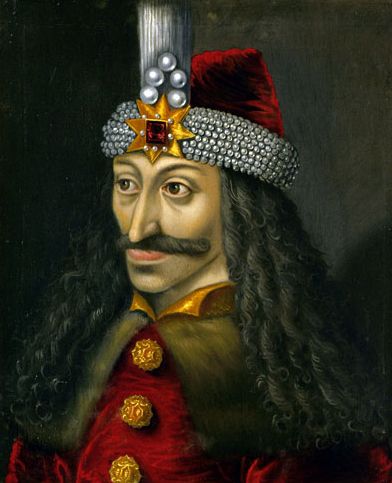
Portrait of Vlad the Impaler
Although Vlad Țepeș passed several times through Brașov, there are no known records of him Vlad the Impaler visiting Bran Castle. Vlad the Impaler mainly ruled from Poenari Fortress. While some claim that Bran Castle inspired the legend of Dracula’s Castle in Bram Stoker’s novel, these claims have no basis.
So as you can see, there are no vast connections between Bram Stoker’s Dracula, Vlad the Impaler, and Bran Castle. Although that does not make the story any less impressive, visitors should always be aware of the difference between the legends and the real history. And as we all know, a written post can never beat a live experience.
The connection between Bran Castle and Queen Marie of Romania
No doubt that Queen Marie of Romania revived the castle that was almost abandoned. The Queen Marie of Romania (1875-1938) was the nephew of Queen Victoria, and she married Ferdinand the future King of Romania in 1893, being considered one of the most beautiful princes in Europe at that time. After the First World War, Transylvania became part of Romania, and the Brasov City Council made a gesture of courtesy to the new Queen of all Romanians, giving the Bran Castel to Queen Marie.
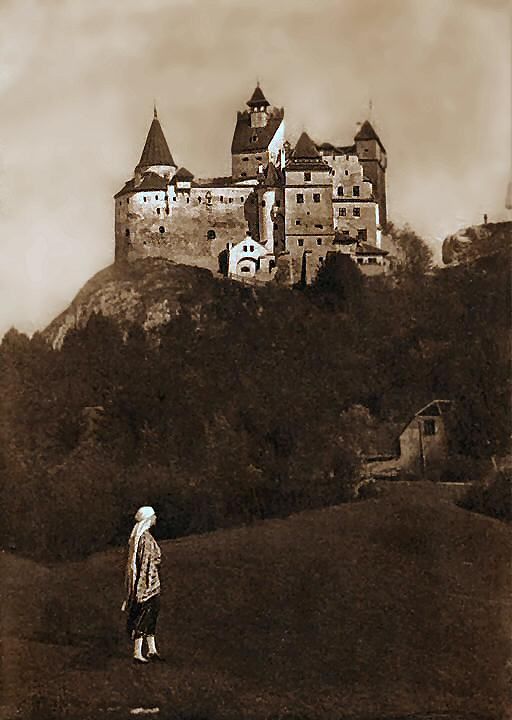
Using her artistic skill, the Queen transforms the Bran Castle with the help of Czech architect Karel Liman in the summer residence alongside the Balcic summer house from the Black Sea. In this period, a traditional house was made of wood- the Tea House (Casa de ceai), a guest house made of stone, a wooden church, and houses for the personnel. Soon the Queen was involved in community life, supporting the families with money and giving the kids a chance to education. At Bran and during the visit to the villages, the queen used to wear traditional Romanian clothes.
Queen Marie was one of the last romantics giving life to the old stones. After her death, according to one of her last wishes, her heart was brought to Bran to be closer to the place that she loved some much and to the grave of her son Mircea who had not yet turned 4 when he died in October of 1916.
Castle visit
If you wish to visit Bran Castle in Transylvania, Romania, you should check the schedule:
Summer Schedule (1st of April- 30 of September)
Monday: 12-18:00
Tuesday to Sunday: 09:00-18:00 (with the last entrance at 18:00)
Winter Schedule ( 1st of October- 31st of March)
Monday: 12:00-16:00
Tuesday to Sunday 09:00-16:00 (with the last entrance at 16:00)
Even if before entrance there are many souvenir shops, unfortunately, most of the products are fake and without nothing to do with the history of the place. An alternative more expensive but with quality products is souvenir shopping inside the castle.
If you are looking for a tour of Dracula’s castle, Rolandia includes the castles in many of his activities. All our Transylvania tours include visits with a specialized tour guide who can offer you detailed information about the castle and the entire context of Transylvania’s history. If you are in Romania for a short time, you can book a private day trip from Bucharest, including Bran Castle, Peles Castle, and Brasov. In case you are looking for unique experiences, we are offering Draculas castle after-hours tours.
Things to do around Bran
Ski
Besides being a great spot to discover the Dracula legend of the infamous vampire lord, Bran offers countless opportunities for activities that can be performed. Four kilometers away from the rustic village, you will find the Zănoaga Ski Slopes, a rather new touristic attraction. The ski slope has three tracks – a 650m long track of medium difficulty, a 700m long track of high difficulty, and a track for beginners. The low and medium-difficulty tracks are equipped with chairlifts and floodlights. You can find an equipment rental center and a first-aid center at the base of the ski slope.
Hiking
Since Bran is located between Piatra Craiului National Park and Bucegi Natural Park, the village is the perfect departure location for several hiking trails. You can choose to explore the beautiful Bucegi Park which is filled with beech forests, greeneries, and alpine rivers. Or you can wander into the wilderness of the Piatra Craiului National Park, rich in wildlife and numerous challenging hikes and climbing routes.
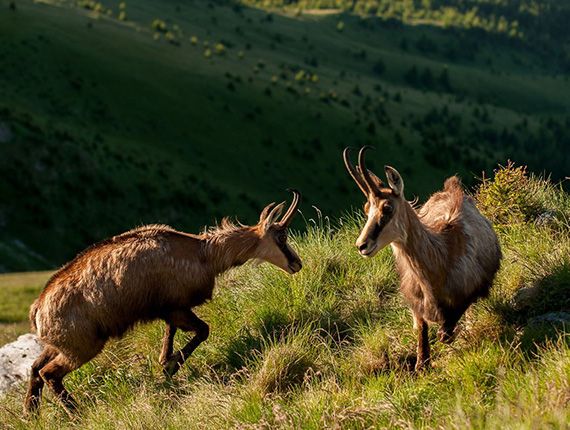
Piatra Craiului National Park
Mountain biking
Bran’s surrounding area is a mountain biking heaven. It is filled with tracks of diverse difficulties that stretch across magnificent landscapes. These biking tracks pass through numerous rustic mountain villages as well. So, whether you’re looking for an adrenaline-filled ride through the mountain tracks, or you want to ride through the plains and meet some of the locals, Bran is a great choice.
Accessibility and accommodation in Bran
Reaching Bran is quite easy, with buses being available from Brașov’s main bus terminal every 30 minutes, and it is also easily reachable by car. As for accommodation, our top choice is the Brătescu Mansion, an authentic Romanian mansion located less than one kilometer away from Dracula’s Castle. The Brătescu Mansion also offers an extensive range of delicious cuisine, from bio meals to traditional Romanian dishes, which are best paired with one of their exceptional wines. At Bran, you will also find several supermarkets and ATMs, so you don’t worry about it.
If you want to find out more specific info about Bran Castle, such as visiting hours & admission fees, head over to their official website.
Rolandia: Your Key to Memorable Exploration
Known as Dracula’s Castle, Bran Castle is a fascinating fusion of myth and history. Even while Bran Castle isn’t the exact location where Bram Stoker set Dracula’s lair, the massive fortification located on a rock certainly conjures up a sense of gothic mystique.
Choose Rolandia as your guide to help you discover Bran Castle’s mysteries. Our knowledgeable guides will enhance your experience with their informative commentary on our Transylvania trips.

